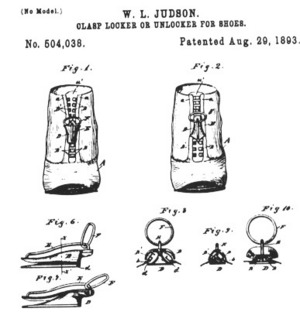Whitcomb L. Judson facts for kids
Quick facts for kids
Whitcomb L. Judson
|
|
|---|---|
 |
|
| Born | March 7, 1843 |
| Died | December 7, 1909 (aged 66) |
| Resting place | Muskegon, Michigan, U.S. |
| Nationality | American |
| Occupation | Salesman, engineer, inventor |
| Known for | Inventor of zipper |
| Spouse(s) |
Annie Martin (m. 1874)
|
| Children | 3 |
Whitcomb L. Judson (born March 7, 1843 – died December 7, 1909) was an American salesman, engineer, and inventor. He is best known for inventing the first version of what we now call the zipper. He called his invention a "clasp-locker." It was first used to fasten shoes and tall boots.
Contents
Early Life
Whitcomb L. Judson was born in Chicago, Illinois, on March 7, 1843. When he was 18, he joined the Union Army in 1861 during the American Civil War. He went to Knox College in Galesburg, Illinois. Later, in 1886, he was living in Minneapolis, Minnesota. He worked as a traveling salesman, selling farm equipment and scales.
His Inventions
Judson started inventing things around 1888. He received 30 patents during his career. A patent is a special document that protects an inventor's new idea.
The Air-Powered Train Idea
Many of Judson's early inventions were about a "pneumatic street railway." This was a type of train system that would run on compressed air. It was similar to cable car systems, but it used air power instead of cables. He received 14 patents for this idea.
Judson even started a company called Judson Pneumatic Street Railway. They built a test track in Washington, D.C., in 1890. It ran for only a few weeks. The system had problems, especially with keeping the air sealed. Because of these issues, the company eventually shut down. Electric streetcars became popular instead.
The First Zipper
Judson's most famous invention was the "chain-lock fastener," which he created in 1891. This was the first version of the modern zipper. He also invented a machine to make these fasteners cheaply.
His invention was called a "clasp-locker." It was a complex system of hooks and loops that could be opened and closed with a sliding part. At first, it was used on shoes. But his patents also mentioned it could be used for things like corsets, gloves, and mail bags. One reason he invented it was to make it easier to fasten the many buttons on the tall boots that were popular back then.
Judson showed his new invention at the Chicago World's Fair in 1893. He started a company called Universal Fastener Company to make his invention. The company moved several times and eventually changed its name to Automatic Hook and Eye Company.
How the Zipper Got Its Name
Judson's "clasp-locker" was not very successful at first. It sometimes broke open unexpectedly. Clothing makers were not very interested in it.
In 1913, a Swedish-American engineer named Gideon Sundback improved Judson's design. Sundback made the fastener much more reliable. His improved version was called "Talon."
In 1918, a company used these fasteners on flying suits for the United States Navy. Soon, they appeared on gloves and tobacco pouches. In 1923, the B. F. Goodrich company used these fasteners on their rubber galoshes (overshoes). They called their new design "Zippers" because of the sound it made when closing. This is how the name "zipper" became popular for the fastener itself. The zippers we use today are very similar to Sundback's improved design of Judson's original idea.
Family Life
Whitcomb Judson married Annie Martin in 1874. They had three children: Jane, Gertrude, and Ross. His son, Ross, later became a vice-president at a company that helped develop the first car hydraulic system.
Later Years
Judson lived in New York City for some time. In 1906, he moved to Muskegon, Michigan. He passed away there on December 7, 1909, at the age of 66.
See also
 In Spanish: Whitcomb Judson para niños
In Spanish: Whitcomb Judson para niños



